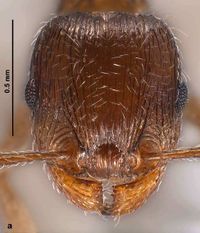Tetramorium fusciclava
| Tetramorium fusciclava | |
|---|---|

| |
| Scientific classification | |
| Kingdom: | Animalia |
| Phylum: | Arthropoda |
| Class: | Insecta |
| Order: | Hymenoptera |
| Family: | Formicidae |
| Subfamily: | Myrmicinae |
| Tribe: | Crematogastrini |
| Genus: | Tetramorium |
| Species: | T. fusciclava |
| Binomial name | |
| Tetramorium fusciclava Consani & Zangheri, 1952 | |
Nests in grasslands, cornfield reins, beaches, pine forests; especially on sandy soil.
Identification
A member of the Tetramorium caespitum species complex. See Wagner et al. (2017) and https://webapp.uibk.ac.at/ecology/tetramorium/ for keys.
Distribution
Latitudinal Distribution Pattern
Latitudinal Range: 44.7333° to 39.89°.
| North Temperate |
North Subtropical |
Tropical | South Subtropical |
South Temperate |
- Source: AntMaps
Distribution based on Regional Taxon Lists
Palaearctic Region: Italy (type locality).
Distribution based on AntMaps
Distribution based on AntWeb specimens
Check data from AntWeb
Countries Occupied
| Number of countries occupied by this species based on AntWiki Regional Taxon Lists. In general, fewer countries occupied indicates a narrower range, while more countries indicates a more widespread species. |

|
Estimated Abundance
| Relative abundance based on number of AntMaps records per species (this species within the purple bar). Fewer records (to the left) indicates a less abundant/encountered species while more records (to the right) indicates more abundant/encountered species. |

|
Biology
Wagner et al. (2017) - More thermophilic than all species except Tetramorium hungaricum, Tetramorium breviscapus, and Tetramorium immigrans; TAS of 13 sites 21.3 ± 1.6 °C [16.1, 21.8]. Preference for to sea. Nests in grasslands, cornfield reins, beaches, pine forests; especially on sandy soil.
No adult sexuals found, records of sexual larvae and pupae from 13 and 14 May.
Castes
Nomenclature
The following information is derived from Barry Bolton's Online Catalogue of the Ants of the World.
- fusciclavum. Tetramorium caespitum var. fusciclavum Consani & Zangheri, 1952: 42.
- [First available use of Tetramorium caespitum subsp. caespitum var. fusciclava Emery, 1925c: 187 (w.) ITALY; unavailable (infrasubspecific) name (Bolton, 1995b: 408).]
- Subspecies of caespitum: Baroni Urbani, 1971c: 138.
- Junior synonym of caespitum: Sanetra, et al. 1999: 320; Radchenko, 2016: 244.
- Status as species: Wagner, et al. 2017: 118 (redescription)
Unless otherwise noted the text for the remainder of this section is reported from the publication that includes the original description.
Description
Worker
Wagner et al. (2017) - Lectotype in μm: CL = 701, CW = 697, dAN = 199, EL = 150, EW = 109, FL = 273, HFL = 584, MC1TG = 19.9, ML = 777, MPPL = 228, MPSP = 298, MPST = 190, MtpW = 336, MW = 422, PEH = 244, PEL = 148, PEW = 217, PLSP = 168, PLST = 186, PnHL = 186, PoOc = 275, POTCos = 9, PPH = 252, PPL = 98, Ppss = 23, PPW = 279, PreOc = 167, RTI = 309, SLd = 564, SPST = 133, SPWI = 170.
Rather small, CS = 724 ± 42 [667, 829] μm. Dark brown to blackish.
Shortest head of complex, CL / CW = 0.996 ± 0.012 [0.976, 1.029]. Largest eye of complex, EYE / CS = 0.188 ± 0.004 [0.183, 0.196]. Scape moderately long, SLd / CS = 0.774 ± 0.006 [0.763, 0.784]. Mesosoma short and narrowest in complex, ML / CS = 1.136 ± 0.021 [1.101, 1.175], MW / CS = 0.615 ± 0.012 [0.596, 0.646].
Promesonotal dorsum convex, metanotal groove shallow. – Head dorsum and occiput with longitudinal costae and costulae. Postoculo-temporal area of head with a moderate number of longitudinal costae and costulae, POTCos = 6.76 ± 2.12 [4.63, 13.50]. Mesosoma dorsum longitudinally rugulose, lateral side of propodeum with pronounced sculpture, Ppss = 30.8 ± 10.5 [15.5, 47.3]. Dorsum of petiolar node typically with few strong costae, sometimes smooth or microreticulated. General surface appearance moderately smooth and shiny compared with other species. – Connected stickman-like or reticulate microsculpture: large units scattered over 1st gastral tergite, MC1TG = 20.57 ± 1.85 [16.34, 23.74]. – Some workers with long c-shaped, crinkly, or sinuous hairs on ventral head posterior to buccal cavity.
Type Material
Wagner et al. (2017) - Riccione (Italy), 43.999° N, 12.656° E, 11 m a.s.l., leg. C. Emery, 1925. Lectotype designation. Top worker of two syntype workers (of two cards on one needle), labeled "Riccione" [–] SYNTYPI Tetramorium caespitum c. var. fusciclava C. Emery, 1925 [–] "var fusciclava Emery" [–] MUSEO GENOVA coll. C. Emery (dono 1925) [–] ANTWEB CASENT 904802, designated as lectotype (Fig. 17). Lectotype worker and one paralectotype worker in Museo Civico di Storia Naturale, Genova (Italy).
References
- Castracani, C., Spotti, F.A., Schifani, E., Giannetti, D., Ghizzoni, M., Grasso, D.A., Mori, A. 2020. Public engagement provides first insights on Po Plain ant communities and reveals the ubiquity of the cryptic species Tetramorium immigrans (Hymenoptera, Formicidae). Insects 11, 678. (doi:10.3390/insects11100678).
- Seifert, B. 2021. Surviving the winter: Tetramorium sibiricum n. sp., a new Central Siberian ant species (Hymenoptera: Formicidae). Osmia 9, 15–24 (doi:10.47446/osmia9.3).
- Wagner, H.C., Arthofer, W., Seifert, B., Muster, C., Steiner, F.M. & Schlick-Steiner, B.C. 2017. Light at the end of the tunnel: Integrative taxonomy delimits cryptic species in the Tetramorium caespitum complex. Myrmecological News 25: 95-129.
References based on Global Ant Biodiversity Informatics
- Consani M., and P. Zangheri. 1952. Fauna di Romagna. Imenotteri - Formicidi. Memorie della Societa Entomologica Italiana 31: 38-48.
- Steiner F. M., B. Seifert, K. Moder, and B. C. Schlick-Steiner. 2010. A multisource solution for a complex problem in biodiversity research: description of the cryptic ant species Tetramorium alpestre sp. n. (Hymenoptera: Formicidae). Zoologischer Anzeiger 249: 223-254.
- Wagner H. C., W. Arthofer, B. Seifert, C. Muster, F. M. Steiner, and B. C. Schlick-Steiner. 2017. Light at the end of the tunnel: Integrative taxonomy delimits cryptic species in the Tetramorium caespitum complex (Hymenoptera: Formicidae). Myrmecological News 25: 95-129.
